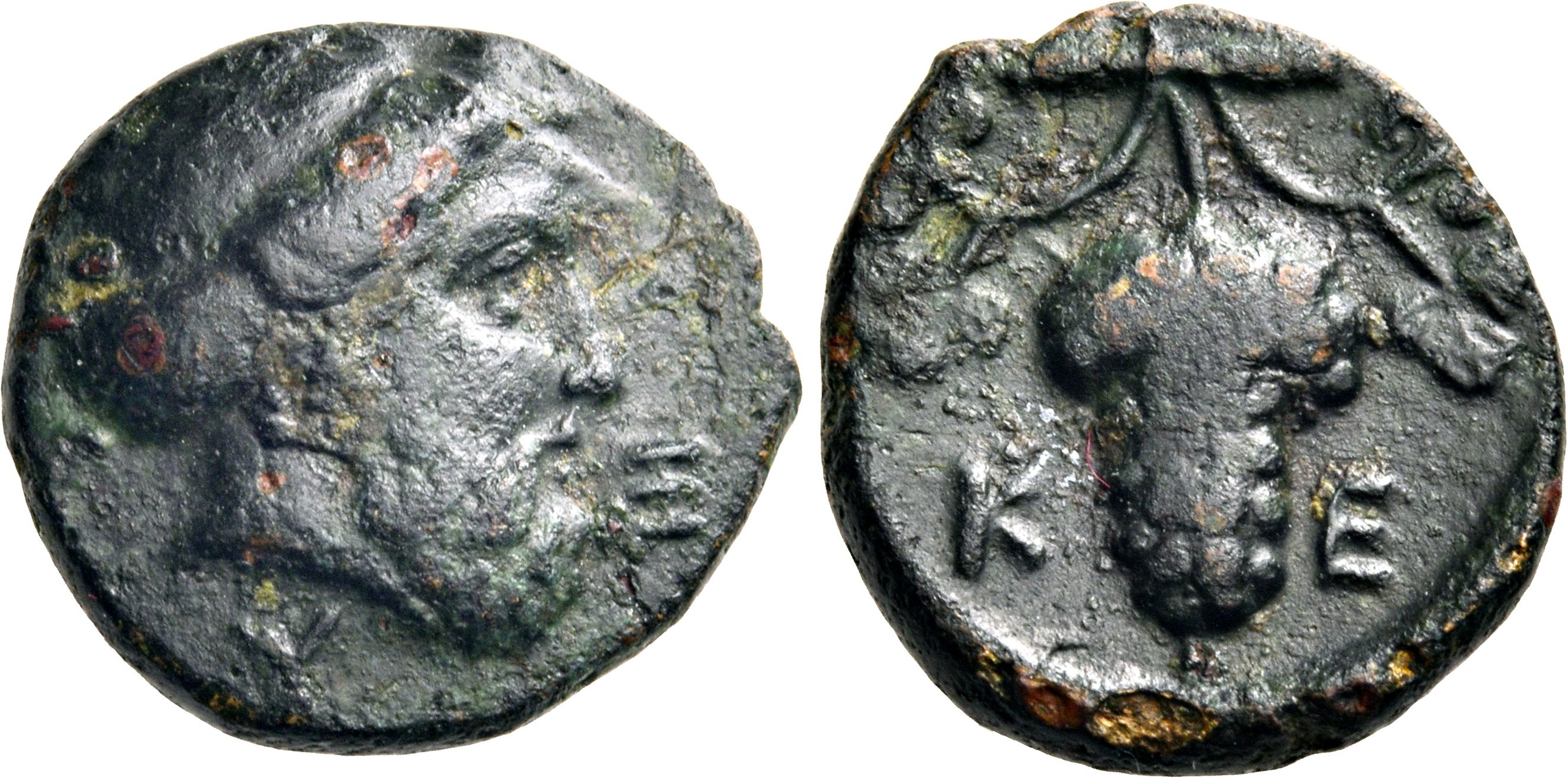S 574 - Kea (uncertain mint), bronze (Aristaeus/grapes) (330-280 BCE)
From SILVER
330 BCE - 280 BCE Bronze
Description
| ObverseInscription or printing placed on the obverse.: | E-Y-Ξ (Greek).Bearded head of Aristaios to right |
| ReverseInscription or printing placed on the reverse.: | KEI (Greek).Grape cluster hanging from a vine branch |
Mint and issuing power
| MintIdentifies the place of manufacture or issue of a numismatic object.: | Kea (uncertain mint) | Ancient regionAncient region.: | Cyclades | Modern countryModern country: Greece | AuthorityIdentifies the issuing power. The authority can be "pretended" when the name or the portrait of X is on the coin but he/she was not the issuing power. It can also be "uncertain" when there is no mention of X on the coin but he/she was the issuing power according to the historical sources: | Keian League |
Chronology
| FromIdentifies the initial date in a range assigned in a numismatic context. | 330 BCE | toIdentifies the final date in a range assigned in a numismatic context.. | 280 BCE | PeriodTime period of the numismatic object.: Hellenistic 323-30 BC |
Physical description
| MetalThe physical material (usually metal) from which an object is made.: | Bronze |
Median weightMedian of the weights of numismatic objects (in grams). in grams | 1.50 | DenominationTerm indicating the value of a numismatic object. Examples: tetradrachm, chalkous, denarius.: | StandardStandard.: |
Image

S574 Keian League.jpg [1]
References
| Die study referencePublication of the study: | Papageorgiadou-Banis 19971Papageorgiadou-Banis 1997, p. 102, n° 1-12 (series I) | ||
| Coin series referenceReference to coin series study: | Sear I2Sear I, n° 3077 | ||
Obverse dies distribution
Reverse dies distribution
no distribution is available
Quantification
| Number of obversesNumber of obverse dies. ᵖ (o) | 11 | Number of singletons (o1)The number of singleton coins. ᵖ | 9 |
| Number of reverse diesNumber of reverse dies. (r) | 9 | Number of coinsNumber of coins. (n) | 15 |
| Coins per obverse dieNumber of coins per obverse die. (n/o) | 1.36 | Coins per reverse dieNumber of coins per reverse die. (n/r) | 1.67 |
| Reverse per obverse ratioRatio of obverse dies divided by reverse dies. (r/o) | 0.82 | Percentage of singletons (o1)number of coins (n) divided by the number of singletons (o1) ᵖ | 81.82 % |
| Original number of dies (O) (Carter 1983 formula)The estimation of the number of coins according to Carter 1983 ᵖ | 32.72 | Coins struck if 20,000 as average productivity per dieCoins made if the average productivity for obverses (according to Carter) is 20,000. ᵖ | 654,400 |
| Original number of dies (O) (Esty 2011 formula)The estimation of the number of coins according to the singleton formula in Esty 2011 ᵖ (O) | 41.25 | Survival rate if 20,000 as average productivity per dieSurvival rate if average productivity is 20,000. ᵖ | 0.00002 |
| Coverage (o = % of O) (Esty 1984 formula)Esty 1984 - coverage (% of O) ᵖ (o = % of O) | 40% | Die productivity if survival rate 1/2,000Average productivity if survival rate is 1/2,000. ᵖ | 916.87 |
| Weight of silver (in kg) if 20,000 coins per die (O = Carter formula)Carter 1983 * Median weight * 20000 (*10 if gold or electrum) ᵖ | n.a. | Die productivity if survival rate 1/5,000Average productivity if survival rate is 1/5,000. ᵖ | 2,292.18 |
Remarks
Most likely one single workstation